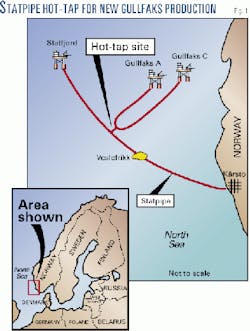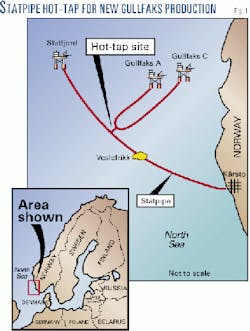Norway's Statoil AS reported earlier this month that a hot-tap operation completed at the end of August has prepared the Statpipe gas trunkline for tie-in of an export line from its Gullfaks field in the Norwegian North Sea.
In addition, Statoil at the end of August shipped out its first cargo of ethane from the newly expanded gas-plant at Karstø.
Hot tap
The pipeline work was done for the Gullfaks Satellites Phase II export line (GFSE) project by divers from Seaway Osprey, operated by the Stolt Rockwater joint venture.
A 30-cm hole was drilled into Statpipe through a welded T joint with a shut-off valve in 135 m of water without halting the gas flow.
The drill was then withdrawn and the valve shut until the Gullfaks gas-export line can be tied in later this autumn, reported GFSE technical manager Olav Hagland.
Tie-ins to the Gullfaks A and C platforms and pressure testing will also be required before the new link can begin operating.
Extending 35 km, the Gullfaks export system was laid this summer in a loop from the A platform to Statpipe and back to Gullfaks C (Fig. 1).
Gullfaks; Statpipe
Statoil says this North Sea link will be very important for the company as a gas exporter and for its Karstø gas treatment complex north of Stavanger: Within a few years, Gullfaks will account for more than half the gas reaching Karstø through Statpipe.
Gullfaks South, Rimfaks, and Gullveig are being developed as Satellites to the main Gullfaks field. A total of 10 subsea templates are tied back via flowlines to the Gullfaks A and C platforms.
The Gullfaks Satellites development is split into two phases.
Phase 1 embraces oil output from all three fields starting production on Oct. 10, 1998. Phase II encompasses recovery of gas with associated oil and condensate from the Brent reservoir in Gullfaks South and is due to come on stream in October 2001.
Total investment is 16.5 billion kroner (approximately $1.82 billion) with Phase I production reaching 125,000 b/d and recoverable reserves at 371 million bbl of oil and 54 billion cu m of gas.
For Phase II, an agreement to deliver 52.7 billion std. cu m of gas has been concluded. This phase will also produce 125.8 million bbl of oil and condensate as well as 5.6 million tonnes of NGL.
Partners in Gullfaks are Statoil at 18%, the Norwegian state's direct financial interest at 73%, and Norsk Hydro AS 9%.
The Statpipe hot tap was only the second of its kind off Norway. Statoil also handled the first one, in 1998, to tie Esso Norge AS's Jotun field to Statpipe.
The Statpipe system links fields in the northern North Sea to the continental European gas market.
On-stream since October 1985, it runs from the Statfjord area via Karstø to the Draupner S riser platform and on to link near Ekofisk with the Norpipe line to Emden, Germany. Including a spur from Heimdal to Draupner S, the system is 880 km long.
Its purpose is to carry large gas volumes from Statfjord, Gullfaks, and Heimdal fields. Other fields that have been tied to the system include Veslefrikk, Snorre, Brage, Tordis, and the Statfjord satellites.
A 15.8-km bypass laid in summer 1998 now carries Statpipe around Ekofisk to tie directly into Norpipe. First gas through this bypass reached Emden on Aug. 23, 1998.
First shipment
The first cargo of liquefied ethane from Statoil's Karstø complex left on Aug. 30 for Bamble, south of Oslo. Statoil said the 2,600-tonne consignment was carried by the tanker Pugliola and is the result of test production at Karstø's new ethane-processing facility.
It represents the first shipment of this commodity from one Norwegian industrial plant to another, according to Statoil.
Plans call for the Clipper Viking and Navion Dania to load ethane twice a week for transport to Norsk Hydro's Bamble petrochemical facility and to the Borealis plant at Stenungsund, Sweden, respectively. Borealis is a Copenhagen-based petrochemicals group owned 50% by Statoil.
The ethane is being separated from gas arriving at Karstø from, among other sources, a soon-to-be-completed pipeline from Statoil's åsgard development in the Norwegian Sea.
In full operation the new plant will have an annual capacity of 620,000 tonnes. Operated by the Statpipe group, it is owned by the Etanor investment company, which belongs in turn to Statoil, AS Norske Shell, Norsk Hydro, Norske Conoco AS, Mobil Exploration Norway Inc., and the Norwegian state's direct financial interest.
Karstø
The Karstø complex, says operator Statoil, has a key role in transporting and treating gas and condensate (light oil) from important areas of the Norwegian continental shelf.
Its original purpose when operations started in June 1985 remains in force today: to receive and treat gas from fields in the northern part of the Norwegian North Sea via Statpipe.
Next month, Karstøwill also start accepting gas from Statoil's åsgard development and other fields in the Norwegian North Sea through the åsgard transport trunkline.
This 42-in., 719-km line will carry gas from åsgard to Karstø; then gas can be sent on through the existing Norwegian transport system in the North Sea. Capacity of the system will be 20 billion cu m/year.
Operator Statoil has 13.54%, the Norwegian state's direct financial interest holds 46.96%, Norsk Hydro Produksjon AS 11.60%, Norsk Agip AS 7.90%, Mobil Development Norway 7.35%, and Fortum Petroleum 5%.
A new facility built at the Karstø complex to process åsgard supplies into sales gas began operations in August. The new processing plant for ethane has an annual capacity of 620,000 tonnes.
At the Karstø complex, processing separates NGL from rich gas arriving by pipeline and splits it into propane, butanes, and naphtha. Propane is stored in two large rock caverns with a combined capacity of 90,000 tonnes. Normal and isobutane plus naphtha are held in tanks.
Statoil ranks Karstø as the world's third largest producer of LPG. The complex received 430 calls in 1999 from ships arriving to load LPG and stabilized condensate.
In addition to the Statpipe-Norpipe system to Emden, lean gas from Karstø moves through Europipe II to Dornum on the German coast. F



